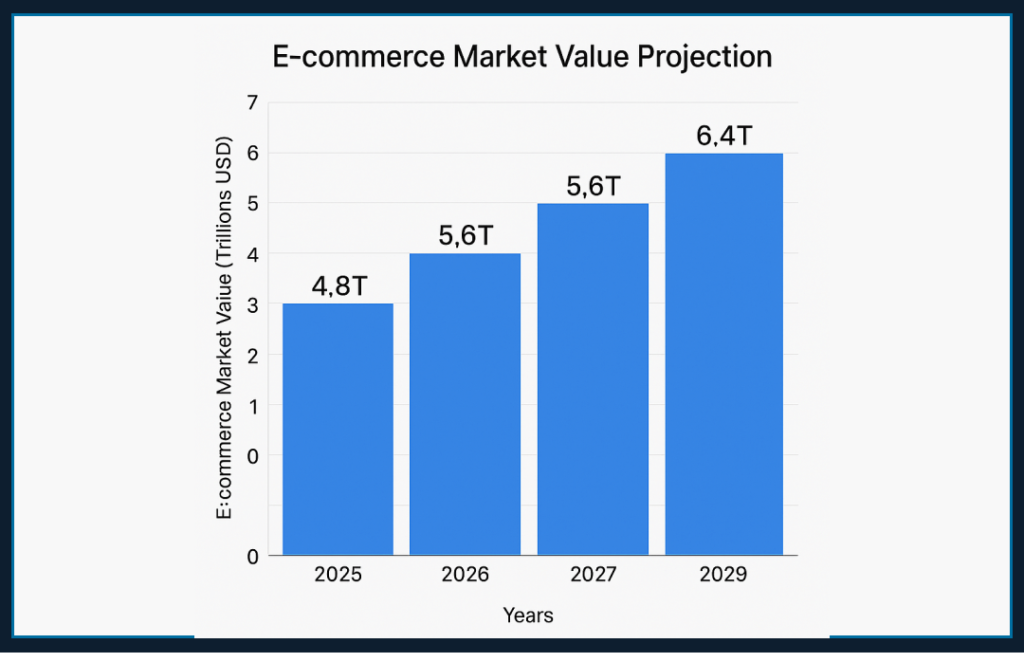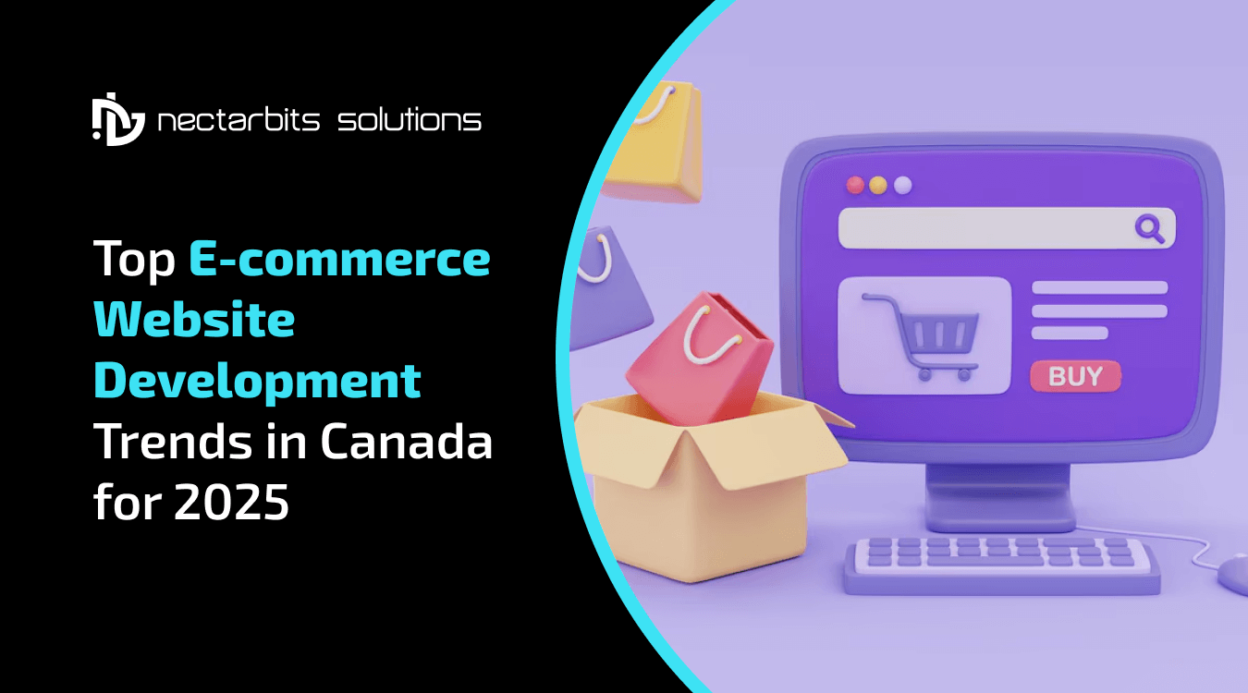Quick summary: Need a solution to stay ahead of the curve right after E-commerce website development in 2025? Adopting the E-commerce Website Development Trends is a way to ride the wave of innovation and scale smartly in the dynamic landscape. Succeed and get future-ready with these trends.
Technology advancement is an answer to evolving customer expectations, and cutting-edge technology adoption is a way for online retailers to live up to or surpass customer expectations. Technology-led innovation is driving the e-commerce market’s growth, which is expected to grow and exceed $4.8 trillion in 2025 to $6.4 trillion by 2029.

As we are halfway through 2025, embracing advanced technologies is integral to the e-commerce development strategy. From hassle-free payment to augmented reality, the immersive shopping experience results from the shift in e-commerce to emerging trends. If you plan to jump on E-commerce website development in Canada, considering the latest E-commerce development trends in 2025, allow your Ecommerce store to make an impact.
This blog will help you walk through top e-commerce development trends in 2025 that will prepare your E-commerce store for the future and ensure continuous success.
Top 10 Ecommerce development trends to succeed in 2025
Delving into the latest Ecommerce development trends and warmly embracing them is a way to make a mark in the online commerce industry. Let’s explore!
Allow customers to experience an in-store feel with AR.
With online shopping, customers experience the lack of in-person product demos, physical try-ons, and the ability to feel the product. That’s why customers started moving to offline shopping. Here, AR technology comes to the rescue with the ability to experience the in-store online. Augmented Reality Shopping in Canada is making new strides.
According to Forbes, AR is a bold innovation that redefines Ecommerce with infinite possibilities. The virtual try-on has already become a standard in the industry, allowing customers to see, touch, and feel how the products look on them. Interactive 3D views of the products enable customers to visualize the product in the physical environment, increasing customer confidence.
Search and shop with voice command.
Voice search has become a part and parcel of every type of search, be it Google search, Ecommerce product search, and others. With smart speakers in every home in Canada, it makes perfect sense to enable an omnichannel shopping experience with voice search capability in regional languages.
Various Ecommerce platforms like- BigCommerce, Shopify, and Magento allow customers to search, shop, and track product orders without lifting their fingers using voice search. The quick and accurate search with voice queries during online shopping increases customer convenience and total sales.
Let intelligent assistants solve customer issues.
AI is now in every corner of the house, automating many things, from refrigerator cooling and AC temperature to switching on/off lights based on human presence. Now, e-commerce is trying its hands-on AI to provide personalized suggestions to customers, customize marketing campaigns, optimize supply chains, and more.
Gen AI is supercharging customer interactions and solving the concerns rightly with contextual, relevant answers. In addition to instant answers to customer inquiries, guided product search with real-time assistance bolsters customer relationships. Connect with an AI company that helps with seamless AI integration in Ecommerce to reap all the benefits it delivers.
Engage customers in real-time with livestream shopping.
The shopping experience is now enhanced with entertainment elements. Livestreaming is one concept that redefines how customers search and shop for products online. Leading e-commerce brands are adopting a live-streaming trend wherein the influencers host live, interactive demos of the products and exclusive discounts to interest the customers, and impulsive shopping is the result.
The live demos are captivating and create a sense of urgency with limited-time offers that engage entirely the customers and instantly shop without asking any questions. Such a trend is increasing conversion and establishing connections with a large user base. It’s visible from growing live-streaming sales in Canada, which are expected to reach $68 billion by 2026.
Deliver personalized experience with customers’ data.
Again, personalization is king in the Ecommerce industry. The AI-powered E-commerce solutions in Canada allow Ecommerce businesses to organize and gain insights from the gathered customers’ data. The data is utilized to tailor every step of the customer journey to deliver personalized experiences and convert them easily.
For example, customers are provided personalized recommendations based on their browsing patterns and purchase history, engaging them during Ecommerce visits. Custom notifications after e-commerce visits push customers to purchase the items they want. Also, customer data collection only after opt-in ensures that the e-commerce business complies with consumer data privacy laws.
Meet mobile shopping needs with mobile responsiveness
One of the biggest trends is the mobile e-commerce trend in Canada, which is skyrocketing with growing mobile usage. The widespread use of mobile phones indicates that revenue from mobile commerce will reach $2.5 trillion in 2025, which is nearly double the total retail e-commerce of the last four years.
The facts require Ecommerce stores to be mobile-optimized so that customers will have a seamless experience across all the devices they use to access Ecommerce stores. Enable one-click order and optimize UI for mobile shopping with reliable mobile app development service providers to make on-the-go shopping more convenient.
Ensure secure transactions through Ecommerce with blockchain
Ecommerce shopping has added the convenience of online browsing, selecting, and paying for products. However, increasing cybercrimes make things difficult for e-commerce stores and customers. Blockchain technology addresses transaction security and transparency issues brilliantly with a unique approach.
With a tamper-proof decentralized ledger that involves smart contracts, blockchain makes it impossible for fraudsters to put a security dent. Smart contracts automate e-commerce transactions with no intermediary involvement, increasing security. Also, customers can check the transaction, track orders, and verify authenticity, which provides a safer Ecommerce experience.
Increase sales with multiple payment options.
Checkout is the touchpoint where most customers abandon the cart, and the topmost reason is the unavailability of the preferred payment option. By enabling flexible payment options, customers can quickly checkout. So, e-commerce stores should allow credit cards, debit cards, payment gateways, digital wallets, and one-click checkout options that lead to higher conversion.
Ecommerce can close more sales with a popular financing option- buy now and pay later at the Brick-and-mortar stores. Encouraging the customers to pay for installments contributes to increased overall sales.
Online shopping has now become a social.
Social shopping penetration is growing across Canada, wherein Facebook stands at the top, Instagram ranks at the second, and TikTok at the third position. The three social channels became a hub for social commerce in 2025. Live shopping and one-click checkout functionality are more user-friendly and increase overall purchases.
Another benefit of social commerce is that small and big e-commerce stores can enable it and improve brand awareness, followed by a smooth experience.
Subscription is a good strategy to retain customers.
The subscription economy is growing across a wide range of industries, including the Ecommerce industry. Various Ecommerce businesses are leveraging the lucrative business model to increase repeat sales, revenue, and loyalty rates. Ecommerce stores club the subscription model with a unique loyalty program, providing early access to upcoming deals or new products, ultimately boosting conversion.
How does Nectarbits help you adopt the right E-commerce trend?
Knowing the Ecommerce development trends for 2025 is good, but they bring extraordinary results only when the right trend is adopted. It’s beyond the bounds of possibilities for Ecommerce stores to decide which Ecommerce development trend they embrace. Here, expert guidance from professional companies like Nectarbits will help them adopt the right trend after evaluating the latest trend, which is the right fit for the Ecommerce brand, and ensure they don’t need to get embarrassed at the later stage for the wrong selection.
Our business consultant and technical analyst harness digital tools and analytics to understand customer behavior, observe competitors, and comprehend cost and ROI ratios so that Ecommerce stores always stay ahead. This approach gives the whole picture and enables informed decision-making. Avail of the E-commerce Website Development Services for extraordinary achievements.
Conclusion
Online shopping is continuously generating higher revenue than in previous years, thanks to technological advancements that are making e-commerce shopping better. In the dynamic environment, cutting-edge technology helps Ecommerce brands evolve according to changing customer expectations and market trends. The latest E-commerce website development trends will allow Ecommerce to deliver an in-store shopping experience, enable social commerce, provide flexible payment, offer a personalized experience, seamless search with voice search, and more.
Embrace the trends strategically with data-driven insights to flourish continuously in the niche industry. Collaborate with an Ecommerce development company to drive better results.

FAQ
1) Which technologies are reshaping Ecommerce?
The technologies that modernize Ecommerce stores with different functionalities are-
– AI technology for virtual assistant or personalization
– Voice search optimization
– AR/VR try-on
– Blockchain to automate and secure transaction
– Headless commerce
2) What’s the future of Ecommerce checkout?
As customers are looking for instant checkout, reduce the number of steps on the checkout page with a one-page checkout. Also, offers diverse payment options and passwordless login through biometric authentication.
3) How much does it cost to implement Ecommerce trends?
Implementing E-commerce trends requires advanced technology integration, which, in turn, requires hiring experienced tech specialists who cost more for every working hour. So, implementing E-commerce trends requires brands to spend between $40,000 and $100,000, depending on the technologies adopted.
4) How to adopt a chatbot intelligently?
AI chatbots are still relevant and leveraged at scale to answer common queries contextually and increase up-sell/cross-sell. Also, the user queries are forwarded to human customer support for complex queries to provide the correct response.
5) How can I improve the Ecommerce store’s security?
Brands can improve Ecommerce security by complying with regulations such as GDPR and PCI-DSS, incorporating anti-fraud tools such as Signifyd, implementing end-to-end encryption to ensure safer transactions, and others.




